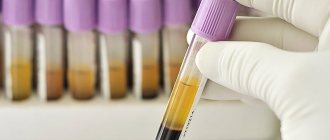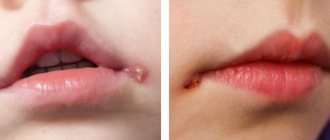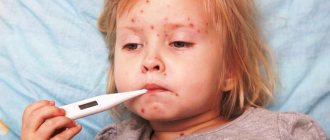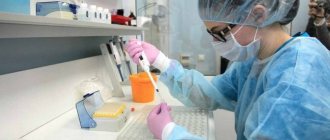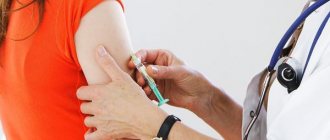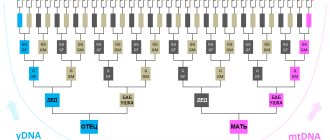Complexes with this research
Future dad Comprehensive examination to prepare a couple for conception 8,460 RUR Composition
Women's check-up No. 1 38 studies for an annual preventive examination 19,290 RUR Composition
Preparation for partner childbirth for a man Tests necessary to accompany a woman in labor RUB 3,680 Composition
IN OTHER COMPLEXES
- Male infertility. Extended examination RUB 29,030
- Examination during pregnancy. 3rd trimester 9,620 RUR
- Entry into IVF RUB 23,020
- Examination during pregnancy. 1st trimester 16,690 RUR
- Hospital complex 2,100 RUR
HIV test procedure
Venous blood is taken on an empty stomach. To avoid unpleasant sensations (dizziness, weakness), it is recommended to drink warm sweet tea or eat a piece of chocolate after donating blood.
Currently, effective antiviral therapy has been developed and the diagnosis “HIV-positive” is no longer a death sentence. Strict adherence to doctor's instructions significantly prolongs the life of HIV-infected people. If you follow your doctor's recommendations and use antiviral therapy, HIV-positive patients can live for decades, the main thing is to make an accurate and timely diagnosis.
When do you need to take an AT and AG test for HIV 1/2 (screening, quality)?
1. Enlarged lymph nodes in more than two areas; 2. Leukopenia with lymphopenia; 3. Night sweats; 4. Sudden weight loss of unknown cause; 5. Diarrhea for more than three weeks of unknown cause; 6. Fever of unknown cause; 7. Planning pregnancy; 8. Preoperative preparation, hospitalization; 9. Identification of the following infections or combinations thereof: tuberculosis, manifest toxoplasmosis, often recurrent herpesvirus infection, candidiasis of internal organs, repeated herpes zoster neuralgia caused by mycoplasmas, pneumocystis or legionella pneumonia; 10. Kaposi's sarcoma at a young age; 11. Casual sex.
Primary blood test for HIV
The ability to detect the presence of HIV in the body appears no earlier than 6 weeks from the moment of infection. For a reliable determination, 6 to 12 weeks must pass from the moment of infection. This is due to the fact that the detection method is based on the detection of antibodies to the HIV virus protein in human blood, and their formation takes time.
The first step in HIV detection is screening detection. It is carried out using the enzyme immunoassay (ELISA) method and is carried out using specially developed test systems. This study is preliminary. If no signs of HIV are detected, the person receives the answer: HIV - negative.
If the test system works and signs of HIV are detected in a person’s blood, then HIV-positive status is not immediately assigned, but the next stage of detection is carried out - verification.
The HIV verification test is carried out using immunoblotting. This detection method is much more complex and is tested using three marker proteins: gp160, gp120, gp41. Moreover, HIV-positive status is assigned only if a positive response is received for all three proteins. If only one or even two are detected, the result is regarded as doubtful. Additional studies are being conducted to confirm or remove HIV-positive status.
If the HIV-positive status is confirmed, a test is performed to determine the viral load. This analysis allows you to determine the amount of virus in a person’s blood and tissues and prescribe the necessary therapy.
Detailed description of the study
RULES FOR CONDUCTING TESTING FOR HIV INFECTION
The primary stage (screening) of HIV testing.
Attention! When taking the AT and AG test for HIV 1/2 for the primary screening study, in accordance with the legislation of the Russian Federation, it is mandatory to provide the following data and documents:
1) For residents of Moscow and the Moscow region
- Full Name
- Day, month and year of birth
- Registration Information
- Passport
2) For residents of other regions of the Russian Federation and foreign citizens, additionally - a photocopy (scan) of the passport.
- Full Name
- Day, month and year of birth
- Registration Information
- Passport
If the above information is not provided, for patients with preliminary positive and questionable results of the screening test for HIV antibodies and antigens ½ (screening) (quality), the test result cannot be issued.
The analysis can be taken anonymously: in this case, the patient is registered as anonymous with an individual order number (clause 2, article 8 of the Federal Law of the Russian Federation No. 38-FZ), with the obligatory indication of the year of birth and place of residence (subject of the Russian Federation).
Draw your attention to! That the results of the primary (screening) study are only the results of a laboratory test and are not the result of an examination or a conclusion about the presence or absence of HIV infection. Based on the results of the screening study, you should contact the municipal AIDS center to conduct a voluntary examination for the presence of HIV.
The results of an HIV test, regardless of their outcome, are issued only if the patient personally contacts the laboratory department. When examining minors (under 14 years of age) - to the legal representative specified in the order.
Results are issued upon presentation of a contract, estimate and identification document of the patient himself or the patient’s representative specified in the order.
Research results are not communicated by phone or email.
With this test, test serum/plasma samples can be simultaneously tested for the presence of HIV type 1 and 2 antigen and HIV type 1 and 2 antibodies.
The human immunodeficiency virus belongs to the family of RNA-containing retroviruses and the subfamily of lentiviruses, i.e. viruses of slow infections. HIV is genetically and antigenically heterogeneous; according to its structure, it is divided into types 1 and 2. When introduced into human cells, the virus forms a DNA section in their genome, which subsequently forms new HIV in unlimited quantities. Viral antigens appear on the surface of damaged cells. The response to their appearance on the part of the immune system is the formation of specific antibodies to the virus of the first or second type. Over the past three years, the number of HIV-infected persons officially registered in Russia has been growing exponentially. The rapid spread of HIV infection in the country may become uncontrollable. Therefore, one of the main tasks at present is the use of more advanced methods of its diagnosis, ensuring the identification of infected individuals at the earliest stages of infection. These methods include laboratory serological tests that determine both the protein structures of the virus and specific antibodies to the virus.
HIV 1, 2 Ag/Ab Combo (determination of antibodies to HIV types 1 and 2 and p24 antigen)
Study of specific antibodies and p24 antigen of the human immunodeficiency virus.
Synonyms Russian
Antibodies to HIV 1, 2, antibodies to human immunodeficiency virus, HIV-1 p24, HIV-1 antigen, p24 antigen.
English synonyms
Anti-HIV, HIV antibodies, human immunodeficiency virus antibodies, HIV-1 p24, HIV-1 Ag, p24-antigen.
Research method
Chemiluminescent immunoassay.
What biomaterial can be used for research?
Venous blood.
How to properly prepare for research?
Do not smoke for 30 minutes before donating blood.
General information about the study
HIV (human immunodeficiency virus) is a virus of the retrovirus family that infects cells of the human immune system (CD4, T helper cells).
HIV-1 is the most common type of virus, most often found in Russia, the USA, Europe, Japan and Australia (usually subtype B).
HIV-2 is a rare type, common in West Africa.
For this study, a fourth-generation combined test system is used, which is capable of detecting HIV infection within 2 weeks after the virus enters the blood, while first-generation test systems do this only 6-12 weeks after infection.
The advantage of this combined analysis is the detection, thanks to the use of antibodies to HIV-1 p24 as reagents, of the specific p24 antigen (viral capsid protein), which can be detected by this test within 1-4 weeks from the moment of infection, i.e. even before seroconversion, which significantly shortens the window period.
In addition, such a study detects antibodies to HIV-1 and HIV-2 in the blood (using the antigen-antibody reaction), which are produced in sufficient quantities to be detected by the test system 2-8 weeks after infection.
After seroconversion, antibodies begin to bind to the p24 antigen, resulting in a positive HIV antibody test and a negative p24 test. However, after some time, both antibodies and antigen will be detected in the blood at the same time. At the terminal stage, an AIDS test for antibodies to HIV may give a negative result, since the mechanism of antibody production is disrupted.
Stages of HIV
- The incubation period, or “seronegative window period,” is the time from the moment of infection until the development of protective antibodies to the virus in the blood, when tests for antibodies to HIV are negative, but the person can already transmit the virus to other people. The duration of this period is from 2 weeks to 6 months.
- The period of acute HIV infection begins on average 2-4 weeks from the moment of infection and lasts approximately 2-3 weeks. At this stage, some people may develop nonspecific flu-like symptoms due to active replication of the virus.
- The latent stage is asymptomatic, but during it there is a gradual decrease in immunity and an increase in the amount of virus in the blood.
- AIDS (acquired immunodeficiency syndrome) is the final stage of development of HIV infection, which is characterized by severe suppression of the immune system, as well as concomitant diseases, encephalopathy or cancer.
Despite the fact that HIV infection is incurable, today there is highly active antiretroviral therapy (ART), which can significantly prolong the life of an HIV-infected person and improve its quality.
This test has a particularly high diagnostic value if HIV infection occurred shortly before the time of testing (2-4 weeks).
What is the research used for?
The analysis is used for early diagnosis of HIV, which allows preventing further transmission of the virus to other people, as well as timely initiation of antiretroviral therapy and treatment of diseases that contribute to the progression of HIV infection.
When is the study scheduled?
- With persistent symptoms (for 2-3 weeks) of unknown etiology: low-grade fever, diarrhea, night sweats, sudden weight loss, enlarged lymph nodes.
- For recurrent herpes infection, viral hepatitis, pneumonia, tuberculosis, toxoplasmosis.
- If the patient suffers from sexually transmitted diseases (syphilis, chlamydia, gonorrhea, genital herpes, bacterial vaginosis).
- If the patient has had unprotected vaginal, anal or oral sex with multiple sexual partners, a new partner, or a partner whose HIV status the patient is not sure of.
- When the patient underwent a donor blood transfusion (although cases of infection in this way are practically excluded, since the blood is carefully tested for the presence of viral particles and is subjected to special heat treatment).
- If the patient injected drugs using unsterile instruments.
- During pregnancy/planning pregnancy (taking azidothymidine during pregnancy, caesarean section to avoid transmission of the virus to the baby during passage through the birth canal, and avoiding breastfeeding reduces the risk of mother-to-child transmission of HIV from 30% to 1%).
- Accidental injection with a syringe or other object (for example, a medical instrument) containing infected blood (in such cases the likelihood of infection is extremely low).
What do the results mean?
Reference values
Result: negative.
Reasons for negative results:
- absence of HIV,
- the period of the seronegative window (neither the antigen nor the antibodies have yet been developed in sufficient quantities necessary for detection by the test system).
Reasons for the positive result:
- HIV infection.
Important Notes
- Diagnosis of HIV antibodies in infants born to HIV-infected mothers is difficult, since the infant receives antibodies from the mother through placental blood. As a rule, the test for HIV antibodies in such children becomes negative no later than 18 months, if the child is not infected with HIV.
- This test cannot determine how long ago you were infected or the stage of HIV (for example, AIDS).
- HIV is found in almost all body fluids, but only in blood, semen and vaginal secretions is the concentration of the virus sufficient for infection. In addition, the virus is unstable and can live only in liquid environments of the human body, so HIV is not transmitted through kissing, insect bites and household contact (for example, when using a shared toilet, through saliva, water and food).
- Although this analysis shortens the “window period,” it is still able to determine the presence of antigen/antibodies no earlier than 1-3 weeks from the moment of possible infection.
- If an event that threatens HIV infection occurs less than 1-3 weeks before testing, it is recommended to repeat the test.
- First- and third-generation tests could give a false-positive result if antibodies to the Epstein-Barr virus, rheumatoid factor, HLA major histocompatibility complex, or antibodies after administration of an HIV vaccine were present in the patient’s blood. However, the likelihood of a false positive result with a combined test is virtually eliminated.
- In case of a positive test result, a confirmatory analysis is performed using the immunoblotting method (a test for antibodies to a number of specific proteins of the virus).
Who orders the study?
General practitioner, therapist, infectious disease specialist, dermatovenerologist.
Preparing the patient for surgical treatment and hospitalization
The nature of preoperative preparation varies depending on the type of disease and the patient’s condition, is determined by the attending physician and is discussed in detail at a consultation in the clinic before hospitalization.
Quitting smoking is necessary for at least 2 weeks - it is necessary to reduce the risk of infectious complications, both pulmonary and from the wound. All patients need elastic knitwear in the form of compression class 1 stockings, while in the presence of varicose veins, lymphostasis or previous venous thrombosis, compression class 2 knitwear is required. Patients with a history of venous thrombosis should undergo ultrasound examination of the deep and superficial veins of the lower extremities before surgery.
Patients with abdominal hernias, as well as those undergoing open (laparotomy) interventions in the postoperative period will need to wear a bandage for 2-3 months after surgery. The selection of anti-embolic stockings and bandages is carried out before hospitalization in the orthopedic salon or pharmacy of our center.
Bowel preparation is not required for most diseases. Your attending physician will inform you in advance about the need to perform bowel preparation for surgery. There is no need to shave the hair in the surgical area yourself; this will prevent pustular skin lesions! You can clarify questions about preparation and examination for surgery by calling a specialist by phone before hospitalization.
By agreement with your attending physician, you can enter the hospital in the afternoon and complete the preparation in our hospital, or come to the clinic early in the morning and complete the preparation yourself. In the evening, the day before the operation, you take a light dinner (for example, a glass of kefir, cottage cheese, soup or porridge). In the evening, before going to bed, you are allowed to drink liquid (water, unsweetened juice, tea) in the amount required for you.
REMEMBER! For the operation to take place, you MUST NOT take liquid or food 4 hours before the operation!
You must have personal hygiene products (soap, toothbrush, toothpaste), underwear, nightgown or pajamas, as well as a passport for drawing up contracts, tests, and a referral for hospitalization. You need to purchase hospital compression stockings of the 1st compression (if you have venous diseases, after consulting a phlebologist, purchase hospital compression stockings of the 2nd compression).
You must bring stockings with you to surgery. The patient puts on compression underwear (stockings) independently, while in a horizontal position on the bed (20 minutes before surgery).
